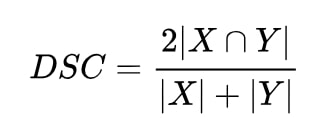This article will explore the Dice Coefficient (DSC), a metric commonly used to evaluate the similarity between two sets. We’ll delve into its definition, provide implementations in NumPy, TensorFlow, and PyTorch, and discuss its practical applications. By the end of this guide, you’ll have a solid understanding of the Dice Coefficient and how to use it in different programming environments.
Dice Coefficient
Also known as the Dice Similarity Coefficient (DSC) or Dice’s coefficient, it is a statistical measure used to gauge the similarity between two sets. It is especially popular in fields like image analysis and natural language processing.
The Dice Similarity Coefficient (DSC)is calculated by dividing twice the number of elements that are in both sets by the sum of the total number of elements in both sets.
Mathematically, it can be defined as:

Here:
- X and Y are the two sets being compared.
- |X ∩ Y| denotes the intersection size of sets A and B.
- |X| and |Y| are the individual sets A and B sizes, respectively.
In the case of boolean data, the dice coefficient can be calculated using the element of a confusion matrix with the following formula.

Here:
- TP – True Positive
- FP – False Positive
- FN – False Negative
ALSO READ: What is Intersection over Union (IoU) in Object Detection?
Implementation
Let’s see how to implement the Dice Coefficient in three popular Python libraries: NumPy, TensorFlow, and PyTorch.
NumPy Implementation
NumPy is a fundamental library for Python numerical computing. Here’s the code for its implementation in NumPy .
import numpy as np
def dice_coefficient_np(set1, set2):
set1 = np.array(set1)
set2 = np.array(set2)
intersection = np.sum(np.logical_and(set1, set2))
return 2. * intersection / (np.sum(set1) + np.sum(set2))
# Example usage
set1 = [1, 0, 1, 0, 1]
set2 = [1, 1, 0, 0, 1]
print("Dice Coefficient (NumPy):", dice_coefficient_np(set1, set2))
Output:
Dice Coefficient (NumPy): 0.6666666666666666
TensorFlow Implementation
TensorFlow is widely used for deep learning and complex numerical computations. Here’s a TensorFlow implementation.
import tensorflow as tf
def dice_coefficient_tf(set1, set2):
set1 = tf.cast(set1, tf.float32)
set2 = tf.cast(set2, tf.float32)
intersection = tf.reduce_sum(tf.multiply(set1, set2))
return 2. * intersection / (tf.reduce_sum(set1) + tf.reduce_sum(set2))
# Example usage
set1 = tf.constant([1, 0, 1, 0, 1])
set2 = tf.constant([1, 1, 0, 0, 1])
print("Dice Coefficient (TensorFlow):", dice_coefficient_tf(set1, set2).numpy())
Output:
Dice Coefficient (TensorFlow): 0.6666667
PyTorch Implementation
PyTorch is another powerful library for machine learning and tensor computations. Here’s how you can implement it in PyTorch.
import torch
def dice_coefficient_pt(set1, set2):
set1 = set1.float()
set2 = set2.float()
intersection = torch.sum(set1 * set2)
return 2. * intersection / (torch.sum(set1) + torch.sum(set2))
# Example usage
set1 = torch.tensor([1, 0, 1, 0, 1])
set2 = torch.tensor([1, 1, 0, 0, 1])
print("Dice Coefficient (PyTorch):", dice_coefficient_pt(set1, set2).item())
Output:
Dice Coefficient (PyTorch): 0.6666666865348816
Precision and Implementation Details
While the core computation remains consistent across libraries, slight differences in precision and implementation details can affect the results:
- Precision and Rounding: Different libraries may use different floating-point precisions, which can result in slight discrepancies in the last few decimal places.
- Data Types: Libraries like TensorFlow and PyTorch might default to 32-bit floats, while NumPy may use 64-bit floats unless otherwise specified.
- Implementation Details: Variations in the implementation of the order of operations can lead to minor differences in the computed values.
These differences are usually minor but can be significant depending on the precision required for your application.
Applications
The Dice Coefficient has numerous applications:
- Medical Imaging: It measures the similarity between segmented regions in medical images, such as tumors.
- Natural Language Processing: It helps evaluate the similarity between sets of tokens or words, useful in tasks like text comparison and information retrieval.
- Computer Vision: It assesses the performance of image segmentation algorithms by comparing the predicted and ground truth segmentations.
Conclusion
The Dice Coefficient is a valuable metric for evaluating the similarity between two sets. Its utility spans various domains, from medical imaging to natural language processing. By implementing it in NumPy, TensorFlow, and PyTorch, you can leverage its power in different computational environments. Understanding and applying it can enhance your ability to measure and improve the performance of models and algorithms in your projects.





